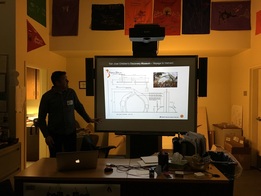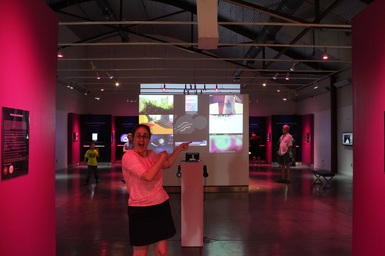|
We often make the mistake, as educators, of going to community and industry partners with our hands out. We ask, "What can industry do for my students? How can industry help" It wasn't until I was talking with a team member at an Adobe field trip that I realized that I tend to swap that request around. My first question, whenever I meet anyone in industry is, "How can my students help you with your business?" It was in the asking of that question, with a team of people from Adobe who happened to be touring my school, that I began what has been a powerful relationship with their company. It turns out that Adobe often wants the feedback of students on product that is in development. They want students who can speak up, are not afraid to offer clear opinions, that are interested in making beautiful images with their products, that understand the basics of project management, and who are generally mature enough to work with a team of adults to communicate clearly what they want and don't want.  To that end, a group of my students were invited to come visit Adobe Headquarters this week, to work with a team of researchers and developers on product. Students got to show the team how they use the product, discuss what they like and don't like, review marketing preferences, and answer a whole host of questions. To some students, it would be intimidating to meet with 15 adults and to be put on the hot seat, but because we concentrate on building collaboration, and oral and written communication skills at New Tech High, these students were up to the task. After having a great working session with the crew and speaking with their research folks, we has an incredibly powerful career panel, where a small team of people with varied job titles at Adobe, spoke to the students about their path from high school to Adobe. They talked about their trials and tribulations, as well as where they chose to pivot to pursue their interests instead of staying on whatever path they thought they were supposed to pursue. The general message was one of supporting students to think about following their bliss, considering design your own majors or double majoring in seemingly disparate subjects, or choosing minors that support their creative passions. The entire trips was eye opening for all the students. They were super grateful to have the time and the special connections they made with folks at Adobe. Surprisingly, the Adobe folks were also super grateful to have the students there. I think that in making industry partners, the relationship has to go both ways. We can not just take, take, take, but also offer added value to our partners, such that we help companies in some way, by offering insight into a demographic they don't normally hear from, or by creating great product that can help companies in their endeavors. What an incredible day. I know it has helped my students gain confidence, gain more clarity about what their next steps are in college and beyond, and it's opened doors for them that would not normally be open. I hope all teachers are on the lookout for ways to partner with industry. Just remember, ask not what your industry partner can do for you, but what you can do for your industry partner!
1 Comment
In our PLC, (Professional Learning Community) we are working in a new cycle of inquiry.
Our question is: How can we better support students to document their growth over time? We are finding that some students just DO NOT like to write reflection pieces, or planning documents, or documents that show what they are learning. We believe there are several factors at play in these situations. 1) Students can have resistance to writing no matter what 2) Students just want to learn, but not document their learning. 3) Students feel that writing about their learning is just a thing that needs to be done to appease the teachers. We have a theory that if we make documentation easier for those students who resist, that are percentage of participation with increase. We will be mining our data from the last two progress reports to see what percentage of participation we got for past reflections and documentation activities. We will then provide video blogging as an alternative to writing and compare percentages of participation again. This will be a 2-3 week research action cycle. Hear from New Tech Network Teachers about what they think of the Innovator's Mindset. Today is the day that our final product from Game Design came to fruition. I can't believe that this actually happened. About six months ago, the curator from the Napa Valley Museum, Meagan Doud, called New Tech High, looking for interns to help with a future exhibit about Indie Games. They sent the call to me, thank goodness! At that time, I boldly suggested that instead of recruiting a few interns, why didn't we just have the two Game Design classes I teach take on the exhibit as a school project? I had no idea how awesome it would be! I took the idea to the students and asked permission to let go of the last project of the year, which was to center around coding and drones. Some were reluctant, because, hey, who doesn't love tinkering with drones? But most saw it as an opportunity to do something real and substantial, related to the Game Industry, a field that about half of the 45 students were interested in entering upon graduation from high school, or college. We split the teams up into different sections, some covering music, art, 3D modeling, video, interactivity, early childhood educational components, game mechanics and game careers. Students picked their own areas of interest and away we went. We met with the curator every two weeks, either in person, or via Skype to review questions, status reports and next steps. Two students, one from each class, came to me and asked if they could be the overall project managers. Could they essentially be in charge of the exhibit? Um....yeah! They happened to be two seniors, one who is pursuing Game Design in college next year, and one who wanted to try on the mantle of leadership. Every team also had team project managers (PMs), who were responsible for communicating with the other team PMs, the Lead PMs and with Meagan. There were several PM meetings outside of class to make sure that everyone was on the same page with the project.  Students were asked to consider several target audiences, ranging from families with small children up to attendees from the Veteran's home on the same campus as the museum. Together, we learned about project management skills, from Gantt charts, to Scrum Meetings, to managing resources and deadlines, to using the Design Thinking Method to get clear about prototypes and deliverables. This was a hefty, real world project. It also turns out that we have a New Tech parent who designs exhibits for a living! At the last moment, he jumped in to show off his own work and help the Game Design students really think deeply about how to best engage exhibit visitors. In addition, students learned about 3D modeling, motion graphics, 2D graphics, color theory, writing for signage and exhibits, research, game mechanics and game careers, prototyping, video filming and editing, presenting, and above all, collaboration. I really do hope, that if you are in the area, that you stop by and see the exhibit. It turned out better than I ever could have hoped and I am SO proud of the work that we ALL did together. "Down the Rabbit Hole" runs from July 15, 2016 through January 8, 2017 at the Napa Valley Museum in Yountville, CA, in the Napa Valley and it features 10 Indie Games. There are some great movie nights and Family Fun Days offered, including a Retro Game Marathon, Model Building, Learning about Binary Code and Pixel Art. Look at the very bottom of the blog post for the info. on the show and activities. For me, finding authentic learning projects is a personal passion, and I am convinced that they can not only be done, but done well, can give students real-world experience, and can provide the impetus for some amazing learning. If you have questions for me about authentic learning projects, you can always contact me on twitter @lisagottfried or leave a comment on this post and I'll get back to you. |
AuthorLisa Gottfried is a CTE teacher with 20 years experience as CEO of her own Video and Motion Graphics Production house. She currently teaches Digital Design at New Technology High School and at Touro University in the Masters of Innovative Learning program. She loves her job and her students! Archives
January 2024
Categories
All
|












 RSS Feed
RSS Feed
